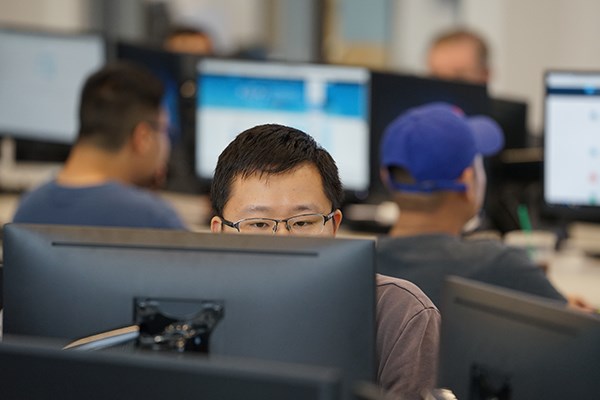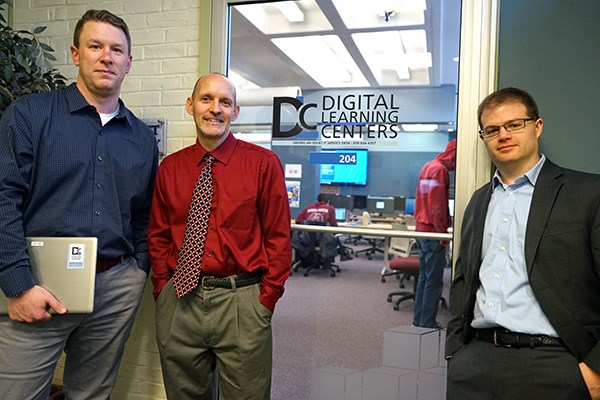With centralized IT support, new DLCs upgrade students’ computing experience
 Image by Ed Brennen
Image by Ed Brennen
01/24/2018
By Ed Brennen
From the 31 PCs in the new Pulichino Tong Business Center trading room, to the 74 Apple iMacs in the Art & Design Department at Mahoney Hall, to the 90 Chromebooks in the Lawrence Lin MakerSpace, students have access to almost any kind of computer they need on campus.
In fact, the university provides more than 1,260 desktops, laptops and tablets in 35 different locations.
To ensure that all those machines are running at peak performance, the Information Technology Office recently established Digital Learning Centers — a new and improved version of standard computer labs.
Whereas most of the university’s computer labs used to be managed and maintained on a departmental level within each college, they will now all be supported by a centralized Digital Learning Centers team.
“We’re here to make sure that Digital Learning Centers are easily accessible, academically effective and fully functional for students and faculty,” says DLC Manager Matthew Conlon, whose four-person team got started last summer by upgrading or refreshing 461 computers in 26 locations across campus.
 Image by Ed Brennen
Image by Ed Brennen
The university invested $173,000 in new computers to replace aging systems in the Engineering, Physics and Art departments, as well as in O’Leary and Lydon libraries. According to Steve Athanas, IT’s associate chief information officer of system architecture, it’s the “largest refresh and replacement of student lab machines that the university has ever done.”
“By having a central team manage DLCs, they will be able to do a better job with less labor, which will allow departments to focus on things other than running labs,” says Athanas, who notes that the new computers are Energy Star-rated, which helps save on the university’s electric bill and lowers its carbon footprint.
Chancellor Jacquie Moloney spurred the DLC initiative last March when she asked the IT department if the university was making the most efficient use of its computer labs. Athanas says that in keeping with the university’s entrepreneurial spirit, the DLCs were born.
“Now we have the flexibility of the decentralized model, but with much higher support levels and a much more consistent framework and experience for students,” Athanas says.
Conlon’s team, which includes six work-study students, does daily walkthroughs of every DLC to inspect terminals, clean screens or even just straighten keyboards. While their top priority is to maintain the hardware, software and printers at each location, they can also help resolve issues like a broken chair or dead light bulb. Each DLC features new signage with the IT Service Desk phone number: 978-934-4357. Issues can also be reported with a help desk ticket.
Most DLCs serve a dual purpose: as a drop-in location for students to do computing and as an instructional space for classes. In Phase 2 of the DLC initiative, Conlon and Athanas say they hope to include digital signage at each location so students can easily see when it’s scheduled to be available. They also plan to create a website and mobile app that will allow students to see exactly which terminals are available, and with what software, at any given moment across campus.
“We’re trying to make the student experience better across the board,” Athanas says.
Senior DLC technician Darren LaRocque has worked to ensure that all 735 vLabs virtual desktops and 532 Macs and PCs have been updated with the most recent operating systems. They all feature OneDrive integration, which allows students to save and access their files on either the virtual or physical computing environment.
To see which computers and software are available in DLCs, Conlon’s team is using LabStats, software that measures technology usage in computer labs. According to LabStats, there were 230,000 unique logins to DLC systems during the fall 2017 semester, which “far exceeded” expectations.
“It gives us the metrics so we can figure out how to put our efforts into places that need it most,” Conlon says. “We can see what is in high demand or if we’re paying for software that people never launch.”
With six computer labs temporarily closed due to renovation work in Perry and Pasteur halls, the DLC team has made 250 vLab-enabled Chromebooks available for class use via mobile carts. The carts, which can hold up to 40 Chromebooks each, are also available in the MakerSpace.
DLC computers are also located in the Solution Center, the Centers for Learning, the Wellness Center and Admissions.
